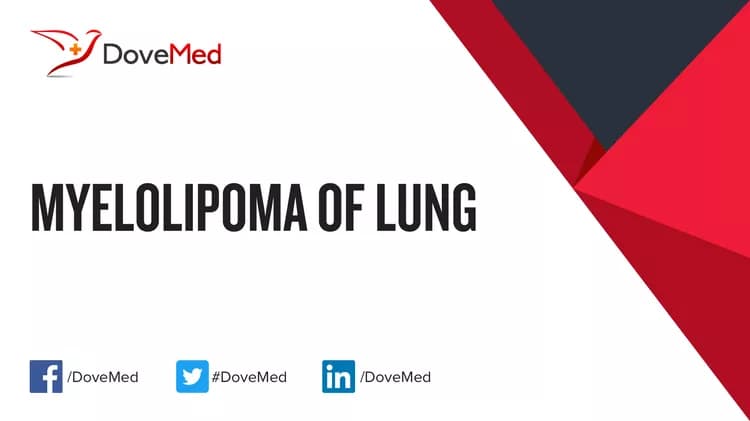What are the other Names for this Condition? (Also known as/Synonyms)
- Intrapulmonary Myelolipoma
- Pulmonary Myelolipoma
What is Myelolipoma of Lung? (Definition/Background Information)
- A myelolipoma is a rare and benign tumor consisting of fat cells and hematopoietic tissue cells (cells that form various blood cells - RBC, WBC, platelets). The tumor name is a combination of the terms marrow (myelo-) and fat (or lipoma)
- A myelolipoma tumor is seen among a wide age range of adults and can occur at various locations in the body. The most common location is the adrenal gland. The lung is an uncommon site for this tumor (the tumor by itself being a rare entity)
- The risk factors for Myelolipoma of Lung are not well-established, and the cause of tumor formation is unknown. Many tumors are found incidentally, while examining the individual for other medical conditions
- Myelolipoma of Lung is often mistaken for lung cancer. The signs and symptoms depend upon the size of the tumor. Large tumors may cause chest pain, cough, and difficulty in breathing (symptoms that are commonly observed)
- Typically, a surgical excision and removal of Myelolipoma of Lung may be undertaken for large tumors or those presenting significant symptoms. The prognosis of Pulmonary Myelolipoma is generally excellent with its complete removal, since it is a benign tumor
Who gets Myelolipoma of Lung? (Age and Sex Distribution)
- Myelolipoma of Lung is a very rare tumor that is mostly observed in adults (age range 45-81 years)
- Both males and females are affected; some studies report a male predilection
- No specific ethnic or racial preference is seen
What are the Risk Factors for Myelolipoma of Lung? (Predisposing Factors)
- Currently, no specific risk factors have been identified for Myelolipoma of Lung
It is important to note that having a risk factor does not mean that one will get the condition. A risk factor increases one’s chances of getting a condition compared to an individual without the risk factors. Some risk factors are more important than others.
Also, not having a risk factor does not mean that an individual will not get the condition. It is always important to discuss the effect of risk factors with your healthcare provider.
What are the Causes of Myelolipoma of Lung? (Etiology)
The exact cause and mechanism of Myelolipoma of Lung formation is unknown.
What are the Signs and Symptoms of Myelolipoma of Lung?
The signs and symptoms of Myelolipoma of Lung depend on the size of the tumor. It is observed that most tumors are asymptomatic, while some individuals exhibit signs and symptoms that include:
- Presence of a single nodule in the lung
- Most tumors are small-sized and may not exhibit any signs and symptoms
- Large tumors (size over 4 cm) can compress the surrounding structures or organs
- The tumor size may range from few mm to nearly 7 cm
- Chest pain and cough
- Difficulty breathing or dyspnea
- Large tumors can cause other obstructive signs and symptoms
- Some tumors may present pneumonia-like symptoms
- Bleeding can occur within large tumors; hemorrhage within the tumors can lead to tissue death (or infarction)
How is Myelolipoma of Lung Diagnosed?
A diagnosis of Myelolipoma of Lung may involve the following tests and procedures:
- Complete physical exam with evaluation of medical history
- Complete blood counts with hematocrit (to detect polycythemia)
- Arterial blood gases
- Lung function test (pulmonary function test)
- Plain X-ray of the chest
- CT or CAT scan with contrast of the chest may show a well-defined mass. This radiological procedure creates detailed 3-dimensional images of structures inside the body
- MRI scans of the lungs: Magnetic resonance imaging (MRI) uses a magnetic field to create high-quality pictures of certain parts of the body, such as tissues, muscles, nerves, and bones. These high-quality pictures may reveal the presence of the tumor
- Sputum cytology: This procedure involves the collection of mucus (sputum), coughed-up by a patient, which is then examined in a laboratory by a pathologist. Even though this procedure may be performed, no tumor cells are generally noted
- Vascular angiographic studies of the tumor
A tissue biopsy refers to a medical procedure that involves the removal of cells or tissues, which are then examined by a pathologist. This can help establish a definitive diagnosis. The different biopsy procedures may include:
- Bronchoscopy: During bronchoscopy, a special medical instrument called a bronchoscope is inserted through the nose and into the lungs to collect small tissue samples. These samples are then examined by a pathologist, after the tissues are processed, in an anatomic pathology laboratory
- Thoracoscopy: During thoracoscopy, a surgical scalpel is used to make very tiny incisions into the chest wall. A medical instrument called a thoracoscope is then inserted into the chest, in order to examine and remove tissue from the chest wall, which are then examined further
- Thoracotomy: Thoracotomy is a surgical invasive procedure with special medical instruments to open-up the chest. This allows a physician to remove tissue from the chest wall or the surrounding lymph nodes of the lungs. A pathologist will then examine these samples under a microscope after processing the tissue in a laboratory
- Fine needle aspiration biopsy (FNAB): During fine needle aspiration biopsy, a device called a cannula is used to extract tissue or fluid from the lungs, or surrounding lymph nodes. These are then examined in an anatomic pathology laboratory, in order to determine any signs of abnormality
- Autofluorescence bronchoscopy: It is a bronchoscopic procedure in which a bronchoscope is inserted through the nose and into the lungs and measure light from abnormal precancerous tissue. Samples are collected for further examination by a pathologist
Tissue biopsy from the affected lung:
- A tissue biopsy of the tumor is performed and sent to a laboratory for a pathological examination. A pathologist examines the biopsy under a microscope. After putting together clinical findings, special studies on tissues (if needed) and with microscope findings, the pathologist arrives at a definitive diagnosis. Examination of the biopsy under a microscope by a pathologist is considered to be gold standard in arriving at a conclusive diagnosis
- Biopsy specimens are studied initially using Hematoxylin and Eosin staining. The pathologist then decides on additional studies depending on the clinical situation
- Sometimes, the pathologist may perform special studies, which may include immunohistochemical stains, molecular testing, and very rarely, electron microscopic studies to assist in the diagnosis
A differential diagnosis, to eliminate other tumor types is considered, before arriving at a definitive diagnosis. The differential diagnosis for Intrapulmonary Myelolipoma includes:
- Hamartoma
- Lipoma
- Phlebangioma
- Teratoma
Many clinical conditions may have similar signs and symptoms. Your healthcare provider may perform additional tests to rule out other clinical conditions to arrive at a definitive diagnosis.
What are the possible Complications of Myelolipoma of Lung?
The complications of Myelolipoma of Lung are dependent upon the size of the tumor and may include:
- Stress and anxiety due to fear of lung cancer
- Severe obstruction of the airways, in case of a large-sized tumor
- Organ dysfunction that may occur from large tumors; large tumors may compress the lungs and heart
- Damage to the muscles, vital nerves, and blood vessels, during surgery
- Post-surgical infection at the wound site is a potential complication
Research has not conclusively proven that myelolipoma can turn malignant.
How is Myelolipoma of Lung Treated?
The treatment measures for Myelolipoma of Lung may include the following:
- Majority of asymptomatic tumors are not surgically removed: The healthcare provider may recommend a ‘wait and watch’ approach for small-sized tumors (not more than 4 cm in size) presenting mild signs and symptoms, after a diagnosis of Pulmonary Myelolipoma is established
- Pain medications for tumors causing pain
- Surgical intervention with complete excision can result in a complete cure; typically, tumors over 7 cm in size or greater are surgically removed. It can also help reduce the chances of tumor recurrence
- Post-operative care is important: A minimum activity level is ensured, until the surgical wound heals
- Follow-up care with regular screening may be recommended by the healthcare provider
How can Myelolipoma of Lung be Prevented?
- Current medical research has not established a method of preventing Myelolipoma of Lung
- Regular medical screening at periodic intervals with tests and physical examinations are recommended
What is the Prognosis of Myelolipoma of Lung? (Outcomes/Resolutions)
- The prognosis of Myelolipoma of Lung depends upon the size of the tumor and severity of the signs and symptoms. It also depends upon the overall health of the individual
- Typically, individuals with small-sized tumors have a better prognosis than those with larger-sized tumors. In most cases, the prognosis of the tumors is excellent with surgical intervention or appropriate treatment, since these are typically benign
Additional and Relevant Useful Information for Myelolipoma of Lung:
Myelolipoma can occur at various locations in the body, such as the adrenal gland, kidney, mediastinum, gastrointestinal tract, and liver.
Related Articles
Test Your Knowledge
Asked by users
Related Centers
Related Specialties
Related Physicians
Related Procedures
Related Resources
Join DoveHubs
and connect with fellow professionals


0 Comments
Please log in to post a comment.